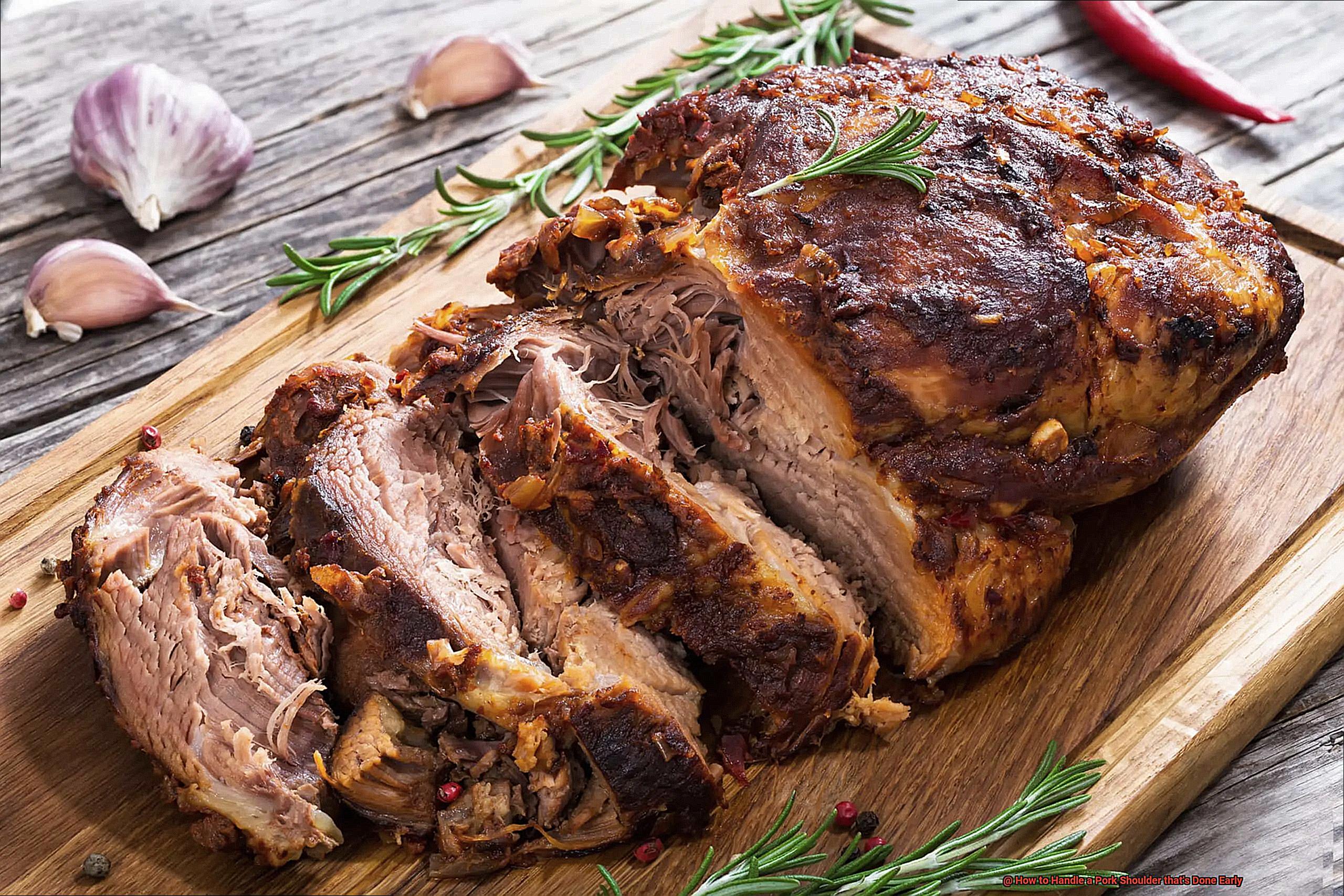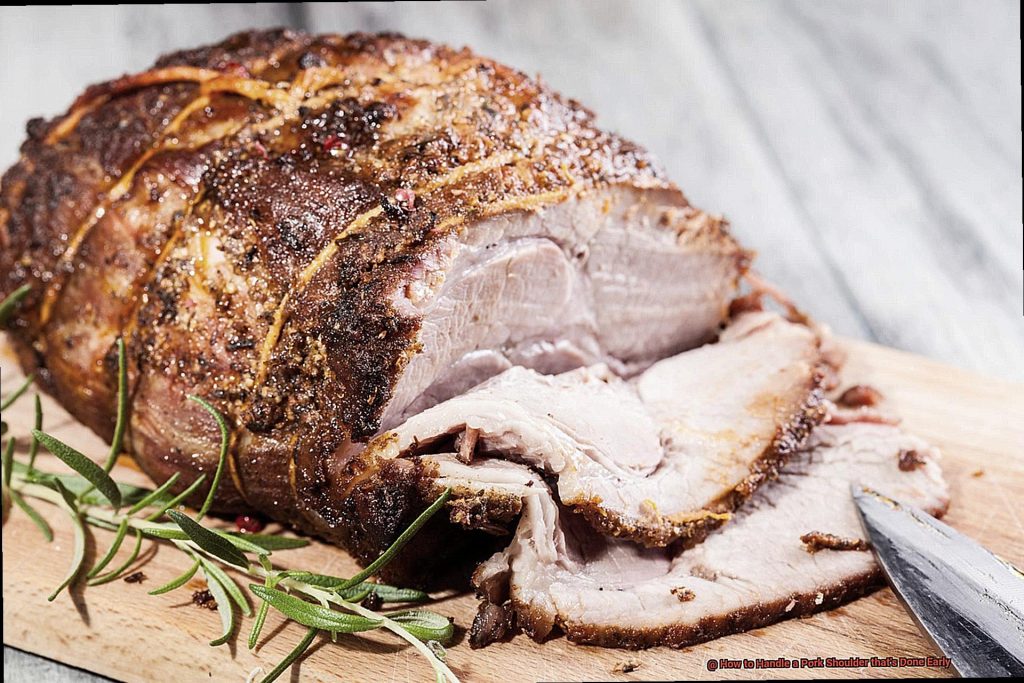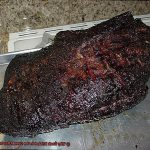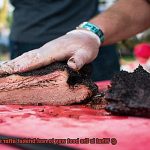Imagine this: You’ve been eagerly anticipating your summer barbecue and have meticulously slow-cooked a succulent pork shoulder.
You followed the recipe to a T, setting the timer for the precise cooking time. But, as luck would have it, your pork shoulder is done early.
Panic sets in – what should you do? Is it safe to take it out of the oven and let it cool before serving?
Or should you leave it in the oven and risk overcooking? Don’t worry; this is a common problem when preparing pork shoulder.
Fortunately, there are ways to handle an early-done pork shoulder without compromising its flavor, texture, or safety. In this article, we’ll share some tried-and-true tips for dealing with this situation.
We’ll cover topics such as how to keep your pork shoulder warm without overcooking it, how to store it correctly before serving, and even how to reheat it if necessary. By the end of this piece, you’ll be equipped with the knowledge and skills to tackle any unexpected occurrences that may arise during your next BBQ.
So, let’s get started now.
Contents
What is a Pork Shoulder?
If you’re new to this cut of meat, get ready for a mouth-watering experience.
Pork shoulder comes from the front leg and shoulder blade of a pig and is also known as pork butt or Boston butt. However, don’t be fooled by those names – it’s not taken from the pig’s rear end.
Pork shoulder is perfect for slow cooking methods, such as smoking or braising. This is because it contains a lot of connective tissue and fat, which break down during cooking to make the meat tender and full of flavor.
It’s no wonder why it’s a popular choice for dishes like pulled pork sandwiches and carnitas tacos. When buying a pork shoulder, you have several options to choose from.
It comes in different sizes and with or without the bone. Opting for bone-in may add some extra flavor, but it will take longer to cook.
When selecting your meat, look for good marbling – those thin lines of fat running through the meat. This will help keep the meat moist while cooking.
But what if your pork shoulder is done earlier than expected?
Follow these simple guidelines to ensure that your meat stays moist and delicious:
- Make sure the internal temperature of your pork shoulder has reached 145°F (63°C) before turning off the heat.
- Wrap it up. To keep its heat and prevent it from drying out, tightly wrap it in aluminum foil or butcher paper once you’ve determined that your pork is done. Allow your pork shoulder at least 30 minutes before slicing. Let it rest so that the juices can redistribute throughout the meat, resulting in a more tender and juicy finished product.
- Reheat as desired. If you need to reheat your pork shoulder before serving, do it slowly over low heat to prevent it from drying out.
- Use leftovers wisely. Don’t let any leftover pork go to waste. Use it in sandwiches, tacos, stir-fries, stews, or casseroles for quick and delicious meals throughout the week.
When is a Pork Shoulder Done Early?
You can still enjoy a delicious meal with these tips. To determine if your pork shoulder is done early, use a meat thermometer.
A fully cooked pork shoulder should reach an internal temperature of 190-200 degrees. If it has hit this temperature before the set cooking time, your pork shoulder is done early.
Additionally, the tenderness of the meat can also indicate whether it’s done. If it shreds easily with a fork, it could be ready sooner than expected.
Now that you know how to tell if your pork shoulder is done early, let’s talk about handling it properly. One option is to let it rest for a longer period of time before serving.
This will allow the juices to redistribute throughout the meat and make it even more tender and flavorful. Think of it like giving your favorite performer time to rehearse their lines; they need time to get into character.
If you’re not ready to serve the pork shoulder yet, wrap it in foil and place it in a cooler or insulated container. This will keep the meat at a safe temperature while still allowing it to cook and become even more tender.
It’s like wrapping your pork shoulder in a warm blanket and letting it continue cooking itself to perfection. It’s important to note that cooking times for pork shoulders can vary depending on factors such as size, cooking method, and oven temperature.
Regularly checking the internal temperature and tenderness of the meat throughout the cooking process will help avoid overcooking or undercooking.
So, don’t worry if your pork shoulder is done early – embrace it.
Check the Temperature of the Pork Shoulder
The first and most crucial step is checking the temperature of the meat.
You want to ensure that the pork shoulder is safe to consume. Checking the internal temperature is the best way to ensure that it’s fully cooked and free of harmful bacteria.
According to food safety standards, the recommended safe temperature for pork is 145°F (63°C). You can use a meat thermometer to check the temperature in the thickest part of the meat, but make sure not to touch any bones as this can give an inaccurate reading.
If the temperature of your pork shoulder is below 145°F (63°C), it’s still not safe to eat. In this case, you will need to continue cooking it until it reaches a safe temperature.
However, if the temperature is higher than 145°F (63°C), congratulations. You have some options.
One option is to let the pork shoulder rest for at least 20-30 minutes before carving it. This allows the juices to redistribute throughout the meat, enhancing its flavor and tenderness.
Imagine wrapping a cozy blanket around your pork shoulder and making it even more delicious. To keep the meat warm during this time, wrap it in aluminum foil or place it in a warm oven (around 170-180°F or 77-82°C).
Another option is to continue roasting the pork shoulder while closely monitoring its temperature. However, be careful not to overcook it as this can result in dry and tough meat.
Remember that even after removing it from the heat source, the temperature will continue to rise slightly. So, consider this when deciding when to take it off the heat.

Wrap It Up
Wrapping your pork shoulder is like tucking it into a cozy bed, keeping the heat and moisture locked in to prevent it from drying out. There are two common methods for wrapping – aluminum foil or butcher paper.
If you opt for aluminum foil, ensure that the shiny side is facing inward towards the pork shoulder. This helps to reflect the heat back onto the meat and keep it warm for longer.
Make sure that the foil is tightly wrapped with no gaps or holes for steam to escape. On the other hand, if you choose butcher paper, wrap the pork shoulder in several layers until it’s completely covered.
Butcher paper allows some air circulation, which prevents the meat from becoming soggy. However, make sure it’s wrapped tightly to prevent any moisture from escaping.
Once wrapped, keep your pork shoulder warm by placing it in a cooler or an oven set to a low temperature (around 200°F). Avoid leaving it out at room temperature for too long as this increases the risk of bacteria growth.
Whether you use aluminum foil or butcher paper, make sure it’s wrapped tightly and stored properly until ready to serve.
Let It Rest
You have successfully cooked a delicious pork shoulder.
But before you dive in with your carving knife, take a moment to appreciate the importance of letting your meat rest. Think of it like a well-deserved break for your hard-working pork shoulder.
Resting your meat allows the juices to redistribute, resulting in a more tender and flavorful final product. This is the time to prepare any sides or sauces to accompany the dish, like adding some spice to your life.
To let your pork shoulder rest properly, cover it with foil and give it at least 30 minutes to cool down. Not only will this prevent all the juices from flowing out, but it also continues to cook the meat internally and kills any harmful bacteria.
So while it’s taking its beauty nap, clean up your cooking area and get your serving dishes ready. Once your pork shoulder has had its well-deserved rest, it’s time to carve it up.
Reheat as Needed
Reheating your pork shoulder is a breeze and it will taste just as good as the day you cooked it.
I strongly recommend reheating your pork shoulder slowly and at a low temperature. This crucial step will help to prevent the meat from becoming tough and drying out.
It is also important to keep in mind that reheating should only be done once to minimize any risk of foodborne illness. Now let’s delve into the best ways to reheat your pork shoulder.
For larger pieces of meat, the oven is the most ideal option. Preheat your oven to 325 degrees Fahrenheit and place the pork shoulder in a baking dish with a small amount of liquid such as water or broth.
Cover the dish tightly with foil and bake for approximately 30 minutes per pound. Check the internal temperature of the meat using a meat thermometer and continue baking until it reaches 165 degrees Fahrenheit.
If time is not on your side, you can opt to reheat your pork shoulder on the stovetop. Slice the meat into smaller pieces, place them in a saucepan with a small amount of liquid, and heat on medium-low heat while stirring occasionally until heated through.
Simply place the meat in a microwave-safe dish with a small amount of liquid, cover it with microwave-safe wrap or a lid, and heat it on high for 1-2 minutes per serving.
J3u60gScW-A” >
Use Leftovers Wisely
First and foremost, let’s talk about shredding. Shredded pork is a versatile ingredient that can be used in multiple dishes.
Just imagine sinking your teeth into a mouth-watering pulled pork sandwich, topped with coleslaw and your favorite BBQ sauce. Or adding some shredded pork to your favorite chili dish for an added kick of protein and flavor.
The possibilities are endless. But why stop there?
Leftover pork shoulder can also be used to make pulled pork sliders or BBQ pizza. And if you have a larger amount, you can freeze it for later use.
Just make sure to store it in an airtight container or freezer bag to prevent freezer burn. Don’t limit yourself to just lunch or dinner, though.
Leftover pork shoulder can also be a game-changer when it comes to breakfast. Add some shredded pork to scrambled eggs, omelets, or breakfast burritos for a protein-packed start to your day.
And lastly, don’t forget about the bones. They may seem like waste, but they are actually a goldmine of flavor.
Simmer the bones with vegetables and herbs for several hours to extract all the delicious flavors and make a flavorful broth or stock that can be used in soups or stews.
By using leftovers wisely, not only are you stretching your budget and reducing food waste, but you’re also enjoying delicious meals without any extra effort.
Also Read: How to Keep Pulled Pork Moist – Pastime Bar And Grill
Conclusion
In conclusion, mastering the art of cooking a succulent pork shoulder requires knowing how to handle it when it’s done early.
Fear not, as there are several ways to ensure that your meat remains juicy, tender, and safe to consume. Firstly, check the internal temperature of the pork shoulder using a meat thermometer.
This will give you an accurate reading of whether it’s cooked through or not. If it’s done early, wrap it up tightly in aluminum foil or butcher paper to seal in the heat and prevent it from drying out.
Secondly, allow your pork shoulder to rest for at least 30 minutes before carving it. This will give the juices time to redistribute throughout the meat and enhance its flavor.
Lastly, don’t let any leftovers go to waste. Use them creatively in dishes such as pulled pork sandwiches, tacos, stir-fries, stews or casseroles for quick and hearty meals throughout the week.
Remember that cooking times for pork shoulders can vary based on factors such as size and oven temperature. However, by keeping a close eye on its internal temperature and tenderness throughout the cooking process, you’ll be able to avoid overcooking or undercoating your meat.






